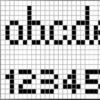Waste canvas is truly a wonderful cross stitch tool; a fabric that allows you to stitch on any fabric or waterproof object. However it also comes with its own set of rules, tips, and techniques that you need to follow in order to get your cross stitch looking exactly how you want it.
So after years of using waste canvas for various projects, I thought I'd put together this comprehensive guide to help you master this versatile technique.
What is Waste Canvas?
Waste canvas is a special type of canvas that's designed to be removed after stitching. It's made from stiff threads that are held together with a water-soluble glue. Once you've completed your cross stitch design, you wet the canvas and carefully remove the threads, leaving only your stitched design on the base fabric.
When to Use Waste Canvas
- Stitching on clothing (t-shirts, jeans, jackets)
- Adding designs to bags and accessories
- Creating cross stitch on home decor items
- Working on fabric that doesn't have an even weave
Materials You'll Need
- Waste canvas (in appropriate count)
- Your base fabric or item
- Embroidery floss
- Sharp embroidery needles
- Embroidery hoop or frame
- Spray bottle or bowl of water
- Tweezers for thread removal
Step-by-Step Process
1. Prepare Your Materials
Cut your waste canvas slightly larger than your design. This gives you room to work and ensures the canvas doesn't shift during stitching.
2. Position the Canvas
Place the waste canvas on your base fabric where you want the design. Make sure it's straight and properly aligned. You can temporarily baste it in place if needed.
3. Secure in Hoop
Place both the waste canvas and base fabric in your embroidery hoop. This keeps everything taut and prevents puckering.
4. Start Stitching
Stitch your design as you normally would, going through both the waste canvas and base fabric. The waste canvas provides the grid structure you need for even stitches.
5. Remove the Canvas
Once stitching is complete, dampen the waste canvas with water. The water-soluble glue will dissolve, allowing you to carefully pull out the canvas threads with tweezers.
Pro Tips for Success
Choose the Right Count
Match your waste canvas count to your desired stitch size. 14-count is most common, but 18-count gives smaller, more delicate stitches.
Use Appropriate Needle
Use a sharp needle rather than a blunt tapestry needle. You need to pierce the base fabric, not just go between threads.
Don't Overtighten
Keep your stitches at normal tension. Pulling too tight can cause the base fabric to pucker or distort.
Remove Canvas Carefully
Take your time removing the waste canvas threads. Pull gently and use tweezers for stubborn pieces. Rushing this step can damage your stitching.
Common Mistakes to Avoid
- Using too much water when removing canvas (can cause fabric to shrink)
- Not securing the canvas properly before stitching
- Choosing the wrong canvas count for your project
- Pulling waste canvas threads too aggressively
Project Ideas
Waste canvas opens up endless possibilities for cross stitch projects:
- Personalized t-shirts and hoodies
- Denim jacket patches
- Decorative towels and linens
- Canvas bags and totes
- Holiday stockings
Conclusion
Waste canvas is an invaluable tool for any cross stitcher looking to expand beyond traditional fabrics. With practice and patience, you can create beautiful cross stitch designs on virtually any fabric. Remember to take your time, especially during the removal process, and don't be discouraged if your first attempt isn't perfect – like any technique, it improves with practice!







